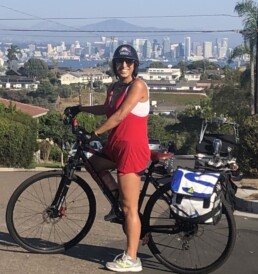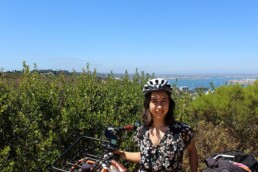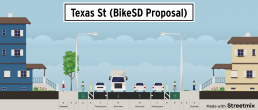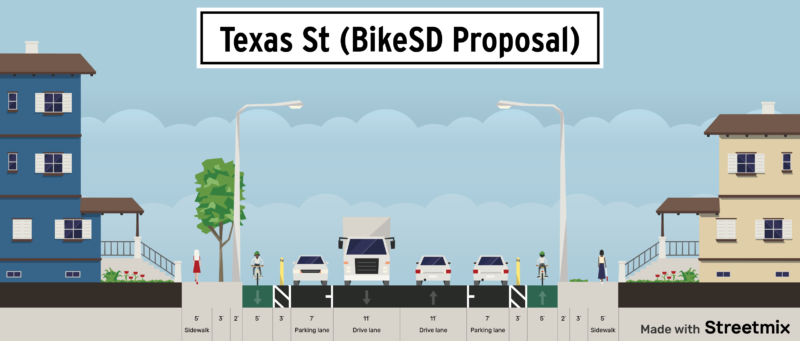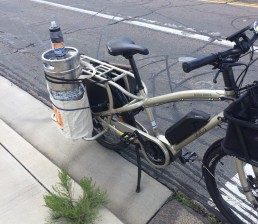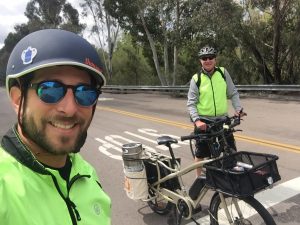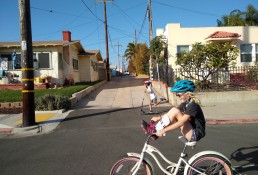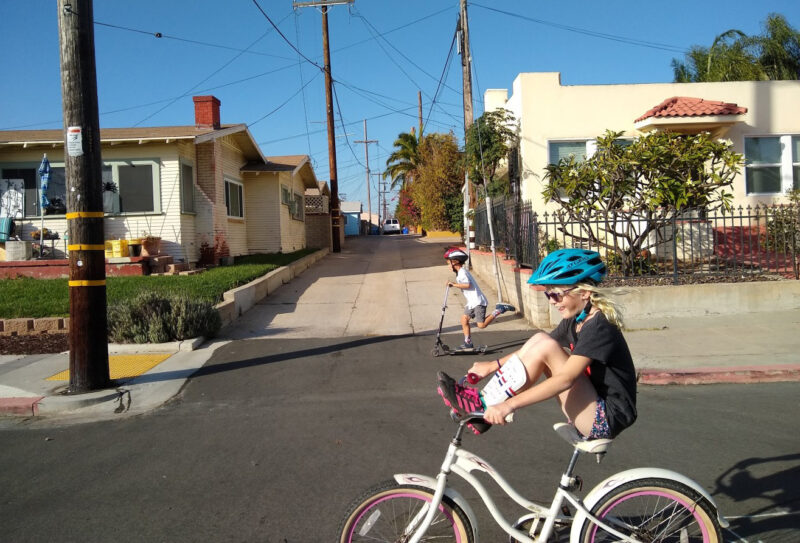Finding the joys of riding a bike at age 54
Jasmine Greene is an amazing kindergarten teacher at Ocean Beach Elementary that all my kids were lucky enough to have as their teacher 15 years ago. After years of not seeing her as much, our lives have come back together as she has found the joys of riding a bike in San Diego. Here is her story of why she started riding and how she has become a new fan of the bike and all the benefits it offers.
- When and why did you start biking in 2020?
For the past year on most weekends two of my good friends, Anna and Leanne, and I had taken on the 52 Hike Challenge. When the trails closed due to COVID, Anna suggested biking instead. I didn’t own a bike and had not been on one for 30 years, so I was a bit nervous about it. We met in University Heights and took our first ride to Seaport Village in April 2020. From that day on I was hooked. I discovered the joy of bike riding at age 54!
- Where do you currently ride and where is your favorite place to ride in San Diego?
I ride from Kensington to Ocean Beach to get to work, twice a week. I sometimes do this with Leanne, but am also comfortable riding on my own now. The one hour ride to and from work is the perfect way to begin and end each day. It clears my head and exercises my body. After riding I feel like I’ve had some time for myself, and am more focused and relaxed. It is something I want to do more often.
My favorite rides are along the coast with friends. Any destination ride is fun to me. I am now ready to tackle any hill! Slow and steady wins the race.
- Did you think it was possible to commute by bike from your house to your work?
Never in a million years would I have thought it was possible for me to ride a bike from Kensington to Ocean Beach. First of all, it just seemed too far and complicated with all the neighborhoods to go through. I had no knowledge of any of the biking routes and the hills seemed ominous.
- What are some of your favorite things about riding a bike?
Taking off on the bike feels so freeing. I love the idea of using my own body to move through time and space. I’m out there alone in the world and yet right smack in the middle of it all. I see so much more than I do driving my car. I have run into many friends along the way. While on my bike I get the enjoyment of seeing lots of dogs, ducks, birds, and even flying fish! I notice what is happening in neighborhoods more intimately; I see store fronts, people exercising and life happening all around me. There is a great feeling of simply being alive and in the midst of it all. Biking has become a type of mediation for me.
- What have you learned about your neighborhood, and our city, while riding a bike?
I had no idea there were so many bike routes. I still feel like a novice in this area. I am unsure of how to get from one place to another by bike in San Diego. This is an area I still struggle with.
Biking has made me very aware of the gravity of San Diego’s homeless population and how far-reaching the issue is. Cyclists are much more confronted with this up close than motorists.
- What are some of your challenges of riding a bike in San Diego?
I have had one minor accident and it woke me up a lot. I’m much more cautious now. One of the biggest challenges are the potholes and road conditions. I ride up Presidio Park to get home from work and the side of the road is full of potholes. The road itself is very narrow, without a dedicated bike lane, so that is always a challenge.
Cars are another major concern. I am fully aware of the fact that in a crash they will win. I am very cognizant of cars while riding, but I can’t always be sure that drivers notice me.
Riding on Adams Avenue and University Avenue regularly, the hazards include people in parked cars opening their doors, cars pulling out abruptly or making illegal u-turns. The buses are sometimes unsettling too.
- As your experiences evolve you as a new rider, how do you envision your riding to be different in 2021?
While I love my hand-me-down bike, I have decided to upgrade and am having a custom bike built with Velofix. This is a local company and one I know I can trust. Having a bike that fits me well is something I am looking forward to. I now consider bike riding a part of my weekly routine. Interestingly, I find myself craving it. I will look for more opportunities to ride s
ocially in 2021.
- Do you have any big requests for our new Mayor to make your riding more comfortable and to encourage others to give it a try?
Help drivers become more aware of bicyclists’ rights. Improve biking infrastructure by creating more designated bike paths so that commuting is safer and viable. Please fix the potholes and other road hazards such as open grates, especially in bike lanes. Increase police presence on more isolated bike paths, such as the Flood Control Channel and the San Diego River Trail.
- What would you say to someone that is interested but concerned to ride a bike?
The most important thing is to be aware of your surroundings. Start by riding with a friend or a group. Learn how to use your gears! Join BIKE SD to track your miles and hear from other cyclists. Give biking a try. I have always been a very active person: running, swimming, hiking, and practicing yoga. Biking was never part of my activity list. It didn’t speak to me until I gave it a try. Then it shouted out loud and clear!
Riding partners Anna and Leanne enjoying San Diego by bike with Jasmine.
Interview by BikeSD Board Member Nicole Burgess
San Diego Can Become a Bike Rider’s Paradise
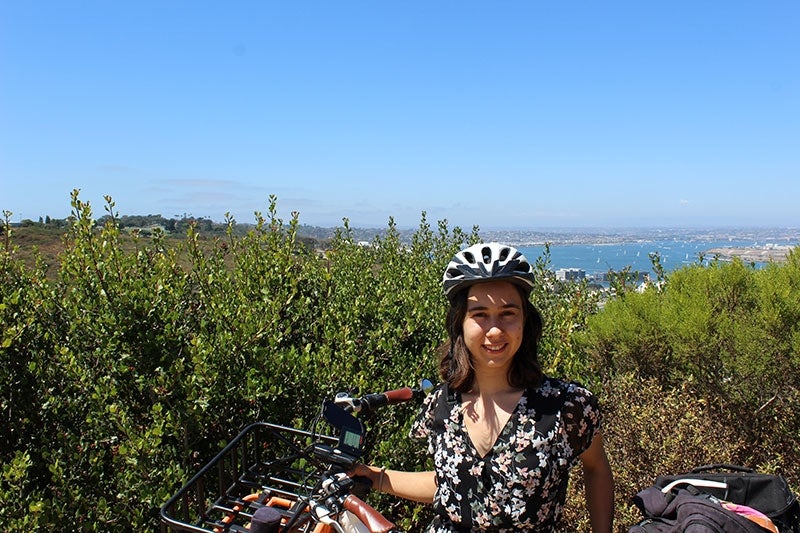
San Diego is the perfect place for a walk, bike ride, scooter ride or hike in the canyons. It rarely rains and the temperature is usually just right.
When moving to San Diego I traded my car for an electric bike and found that this beautiful city has some wonderful bike infrastructure and new protected lanes are being discussed and installed right now. I take my bike to the grocery store, out to restaurants and to commute to my small business in Liberty Station.
A little over a year ago I would have been baffled that I could build and run a pottery studio without a car, now I can’t imagine anything else. The money that I would have put into owning a vehicle, gas and insurance I now put into my business. My electric bike makes a five- or six-mile commute hauling clay and equipment easy and fun.
Leah Schaperow
Hillcrest
This letter originally appeared as a letter to the San Diego Union Tribune and was written by BikeSD board member Leah Schaperow.
A Vision for Texas Street
By Nevo Magnezi, BikeSD Board Secretary
On August 18, 2019, Tom Morris, a man with a walker, was killed due to traffic violence while trying to cross Texas St in North Park. On November 17 of the same year, a 33-year old man was killed, also trying to cross Texas St, this time by a big rig truck. They join 6,590 other Americans who were killed in 2019, doing something that comes naturally to all of us: getting around on foot. Indeed, 2019 saw the highest pedestrian fatality rate in the United States since 1988.
Other cities in developed countries don’t seem to have this issue. Oslo and Helsinki saw zero pedestrian deaths in 2019. This success is not because our Nordic friends are less likely to jaywalk. Rather, it is because urban planners in those places design their built environment to be safer and more forgiving to human error. The tired excuses that San Diego is so distinct from other places that we must simply accept the killing of our community members cannot be tolerated. We can and must do better to make our entire transportation system safer.
So what makes Texas Street so deadly? Between wide streets, heavy traffic, insufficient pedestrian crossings, and a complete lack of any biking infrastructure, Texas Street is not designed for humans in mind.
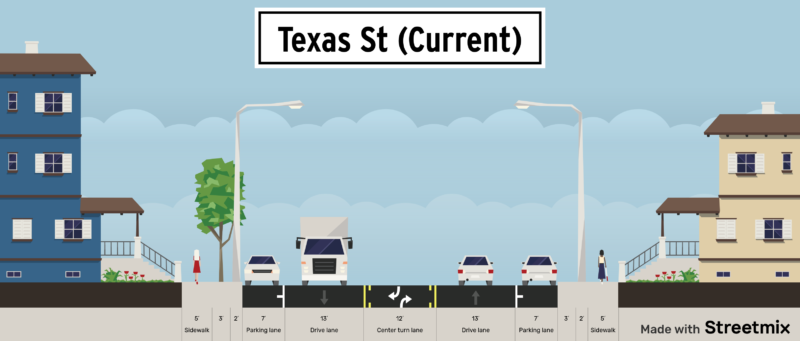
As city planners know well, speed kills. The National Association of City Transportation Officials, or NACTO, recommends that lane widths be 10 feet in urban areas to reinforce a 25mph speed limit, or 11 feet for designated bus and truck routes such as Texas St. The current distance from the edge of the street parked cars and the line delineating the center turn lane is 14 feet. The city must reinforce a design that truly limits vehicle speeds to 25mph, and that means ensuring lanes are only as wide as their intended use.
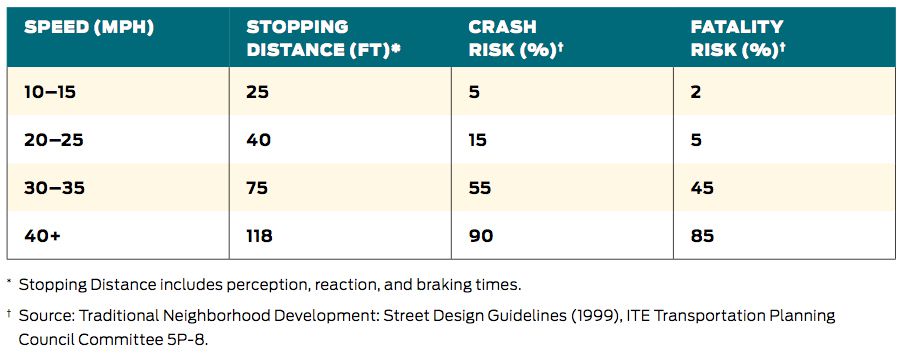
With two 11 foot vehicle lanes, the pedestrian crossing distance, should naturally be no more than 22 feet. By implementing mini-roundabouts, as done on Meade Ave, in conjunction with pedestrian refuge islands and curb extensions, the pedestrian crossing distance can be reduced to 11 feet at intersections. Furthermore, raised continental crosswalks implemented at every intersection could further increase the visibility of pedestrians and provide much needed mobility to disabled folks who currently cannot cross at many of the intersections.
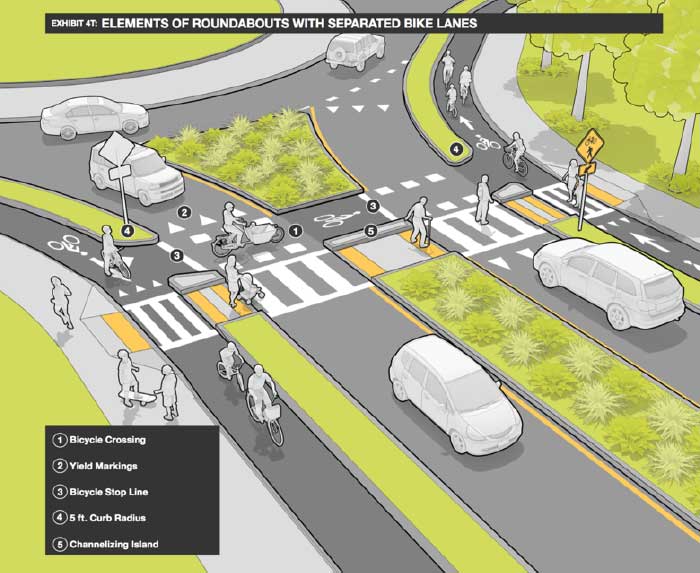
With each vehicle lane width of 11 feet and 7-8 feet for street parking, that leaves 16 feet left on this 52 foot wide street. We believe that the best use of the remainder of the street width would be for two 8 foot wide cycletracks, including buffer, adjacent to the curb. Similar designs of sandwiching cycletracks between the sidewalk and street parking have successfully been implemented in many other cities as well as downtown. We note that the North Park Community plan calls for a class II bike lane facility, which makes sense, as in addition to being a bus, truck, vehicle, and pedestrian route between North Park and Mission Valley, Texas Street is also a bike route and has class II bike lanes north of Madison Avenue. That being said, we believe a class IV cycletrack is more appropriate for Texas street between Madison Avenue & University Ave because of the NACTO recommendation that streets with a speed of 25mph and an average daily traffic volume of greater than 6,000 vehicles be equipped with protected bike lanes, in order to become a facility suitable for all ages and abilities.
Finally, we would like to note that we think it would be great to keep the approximately 98 public street parking spaces, according to our count, on Texas St between Madison Avenue and El Cajon Boulevard, as well as points south. Parked cars can further provide protection and limit speeds by making the lane feel even narrower to drivers, and offer convenience to those who drive in the neighborhood. However, our top priorities must be satisfying our vision zero and climate action plan goals. Ultimately, we defer to the expertise of our city planners in determining how much street parking can be maintained.
No doubt, building roundabouts, protected bike lanes, and extending curbs will be costly. While BikeSD is not qualified in estimating the total cost, it is worth noting that in 2013, the state of California determined the economic loss associated with each traffic violence death to be 1.32 million dollars. With two deaths and twenty five reported injuries since the beginning of 2018, building a safer Texas Street will be a steal in comparison to doing nothing. The state provides funding for jurisdictions to build complete streets through SB-1, however so far the city has not used any of that money explicitly for that purpose. We ask that the City of San Diego use all available funding sources, including SB-1, in order to ensure that Texas Street becomes safe for users of all ages and abilities.
Local Cargo by Adam Deutsch
These are days where I think about how many post-apocalyptic narratives neglect the bicycle. We’re not at the end of world, but my motivation to bike came from the sense that driving made other activities almost impossible.Read more
10 Years Riding the Bus = $84,000 Saved
Sitting on the couch last night was chatting with the spousal equivalent (“SE”) about how NextDoor is awful. Cue a recent bus rider shaming post that really bothered me:
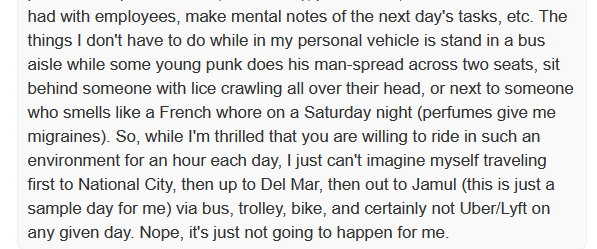
We talked a bit and then realized SE has been riding the bus to work, or biking, for the last 10 years. Wow, time flies. Somehow, neither lice nor French whore encounters have been a problem. #praise
There are a number of reasons that transit SE likes to support and use transit:
- Traffic congestion reduction (buses move far more people than the typically single occupant cars common in the US)
- Cost savings
- Reduced environmental impact
- Social unity / exposure
- Etc
On the cost savings front we estimated that over the last 10 years we saw approximately $84,000 of savings for our family.
- $200 per month parking x 10 years = $24,000 (Comparison from co-workers)
- $6000 per year vehicle cost x 10 = $60,000 (About 1/3 less than the average cost per year from AAA since Cali is hella expensive but we’re cheap. Results may vary.)
SE bus cost is covered by employer so if paying the $72 monthly out of pocket would reduce the savings by $8,640 for a total 10 year savings of roughly $75,360.
We took the savings and went on a fat family trip to Vegas and Hawaii which was awesome. Just kidding. We put most of it into index fund investments to grow and throw off dividends until the end of our days.
Wanted to share our public transit savings story in case you’re also interested in saving the better part of $100k every 10 years and putting it to work for you instead of sending it out the exhaust pipe.

